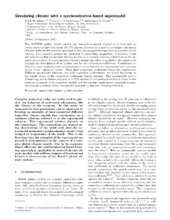Simulating climate with a synchronization-based supermodel
Peer reviewed, Journal article
Published version

Åpne
Permanent lenke
https://hdl.handle.net/1956/18589Utgivelsesdato
2017-12Metadata
Vis full innførselSamlinger
- Geophysical Institute [1195]
Originalversjon
https://doi.org/10.1063/1.4990721Sammendrag
The SPEEDO global climate model (an atmosphere model coupled to a land and an ocean/sea-ice model with about 250.000 degrees of freedom) is used to investigate the merits of a new multi-model ensemble approach to the climate prediction problem in a perfect model setting. Two imperfect models are generated by perturbing parameters. Connection terms are introduced that synchronize the two models on a common solution, referred to as the supermodel solution. A synchronization-based learning algorithm is applied to the supermodel through the introduction of an update rule for the connection coefficients. Connection coefficients cease updating when synchronization errors between the supermodel and solutions of the “true” equations vanish. These final connection coefficients define the supermodel. Different supermodel solutions, but with equivalent performance, are found depending on the initial values of the connection coefficients during learning. The supermodels have a climatology and a climate response to a CO2 increase in the atmosphere that is closer to the truth as compared to the imperfect models and the standard multi-model ensemble average, showing the potential of the supermodel approach to improve climate predictions.